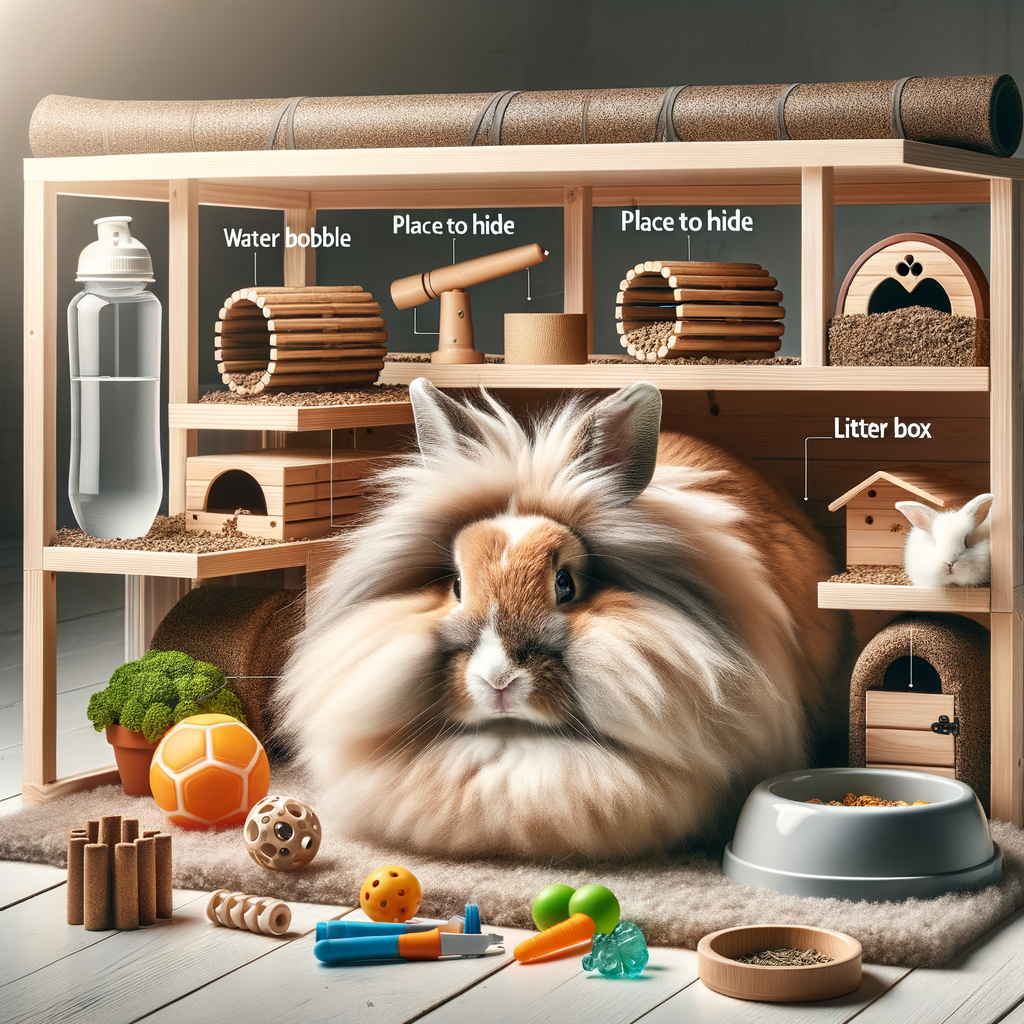
Introduction to Lionhead Rabbit Indoor Care
When it comes to caring for a Lionhead Rabbit, understanding their specific needs is essential. These adorable creatures are not just any ordinary rabbits. They require special care and attention, especially when kept indoors. In this article, we will explore the needs of Lionhead Rabbits and the benefits of indoor rabbit housing.
-
Understanding the Needs of Lionhead Rabbits
Lionhead Rabbits are unique pets with specific needs. They are known for their distinctive mane of hair, resembling a lion’s mane, hence their name. These rabbits are small in size, but they have a big personality. They are friendly, playful, and love to interact with their human companions.
When it comes to their diet, Lionhead Rabbits need a balanced mix of hay, vegetables, pellets, and fresh water. They also need regular grooming due to their long hair. Regular vet check-ups are also essential to ensure they are healthy and happy.
Like all rabbits, Lionheads are social animals. They need plenty of interaction and playtime. If they are kept alone for too long, they can become bored and depressed. Therefore, it’s important to spend quality time with your Lionhead Rabbit every day.
-
Benefits of Indoor Rabbit Housing
Keeping your Lionhead Rabbit indoors has many benefits. For one, it protects them from harsh weather conditions and predators. It also allows you to monitor their health and behavior closely.
Indoor housing also provides a safe and comfortable environment for your rabbit. You can control the temperature, humidity, and light, ensuring your rabbit’s comfort at all times. Plus, it allows for more interaction and bonding time with your pet.
However, indoor housing requires proper setup and maintenance. You need to provide a spacious cage or enclosure, litter box, toys, and other necessities. Regular cleaning is also essential to prevent odors and maintain hygiene.
In the following sections, we will delve deeper into the ideal living conditions for Lionhead Rabbits, explore various indoor housing options, address common concerns about keeping rabbits indoors, and share a case study of successful indoor living for Lionhead Rabbits. Stay tuned!
Understanding Rabbit Living Conditions
When it comes to the living conditions of rabbits, particularly Lionhead Rabbits, there are several factors to consider. One of the most critical decisions you’ll need to make is whether to house your rabbit indoors or outdoors. Both options have their pros and cons, and the best choice depends on your rabbit’s specific needs and your living situation.
Outdoor vs Indoor Housing for Rabbits
Let’s delve into the differences between outdoor and indoor housing for rabbits, and why indoor living can be particularly beneficial for Lionhead Rabbits.
- Comparing outdoor and indoor environments
- Why indoor living can be beneficial for Lionhead Rabbits
Outdoor environments can provide rabbits with plenty of space to hop around and explore. However, they also expose rabbits to weather extremes, predators, and diseases. On the other hand, indoor environments are safer and more controlled. They protect rabbits from external threats and allow for closer monitoring of their health and behavior.
Lionhead Rabbits, with their distinctive mane of fur around their heads, require more care and attention than some other rabbit breeds. Indoor living can be beneficial for them because it allows for regular grooming, which is essential to prevent matting and other fur-related issues. Also, being indoors makes it easier to maintain a consistent temperature, which is crucial for this breed’s comfort and health.
Let’s look at a comparison table to better understand the differences between outdoor and indoor living for rabbits.
| Outdoor Living | Indoor Living | |
|---|---|---|
| Space | More space for exploration | Space can be limited but can be managed with proper planning |
| Safety | Exposure to predators and diseases | Protection from external threats |
| Temperature Control | Subject to weather extremes | Consistent and comfortable temperature |
| Care and Attention | Less opportunity for regular grooming and monitoring | Allows for regular grooming and close monitoring of health and behavior |
In conclusion, while outdoor living offers more space, the safety, temperature control, and opportunity for regular care and attention provided by indoor living make it a more suitable option for Lionhead Rabbits.
Creating the Ideal Lionhead Rabbit Habitat Indoors
Creating a comfortable and safe indoor habitat for your Lionhead rabbit is crucial for its health and happiness. This involves providing adequate space, ensuring proper ventilation, and maintaining cleanliness. Let’s delve into these essential components of indoor rabbit care.
Essential Components of Indoor Rabbit Care
- Providing Adequate Space
- Ensuring Proper Ventilation
- Keeping the Environment Clean
Lionhead rabbits are active and playful creatures. They need plenty of space to hop around and explore. A small cage or hutch won’t do. The House Rabbit Society recommends at least 8 square feet of housing area and at least 24 square feet of exercise space for one or two rabbits. This space should be safe and free from hazards such as electrical wires and toxic plants.
Good ventilation is vital for your rabbit’s health. Stagnant air can lead to respiratory problems and other health issues. Make sure your rabbit’s living area has plenty of fresh air, but avoid direct drafts. A room with a window that can be opened for fresh air is ideal. However, make sure the window is secure to prevent escapes.
Keeping your rabbit’s habitat clean is essential to prevent diseases. Rabbits are clean animals and they do not like to live in dirty environments. Regularly clean the cage or hutch, removing soiled bedding, droppings, and uneaten food. Use a pet-safe disinfectant to clean the cage at least once a week. Also, provide a litter box for your rabbit and train it to use the box.
In conclusion, creating the ideal indoor habitat for your Lionhead rabbit involves providing enough space, ensuring proper ventilation, and maintaining cleanliness. By following these guidelines, you can create a comfortable and safe environment for your furry friend.
Exploring Rabbit Housing Options
When it comes to housing your Lionhead rabbit indoors, there are a variety of options available. It’s essential to choose the right one to ensure your rabbit’s comfort and well-being. Let’s explore some of the best indoor enclosures for your rabbit.
Choosing the Right Indoor Enclosure for Your Rabbit
Choosing the right indoor enclosure for your rabbit is crucial. It should be spacious enough for your rabbit to move around freely and should also be safe and secure. Here are some options and factors to consider:
- Types of Indoor Rabbit Enclosures
- Cages: These are the most common type of rabbit housing. They come in various sizes and designs. Some even have multiple levels for your rabbit to explore.
- Playpens: These are larger and offer more space for your rabbit to move around. They can be used as a primary enclosure or as an additional space for your rabbit to play and exercise.
- Rabbit Condos: These are multi-level structures that provide lots of space and enrichment for your rabbit. They are ideal for rabbits that spend a lot of time indoors.
- Factors to consider when choosing an enclosure
- Size: Your rabbit needs plenty of space to move around. The enclosure should be at least four times the size of your rabbit.
- Security: The enclosure should be secure to prevent your rabbit from escaping and to keep predators out.
- Comfort: The enclosure should have a comfortable area for your rabbit to rest and sleep.
- Enrichment: The enclosure should have toys and other items to keep your rabbit entertained and stimulated.
There are several types of indoor rabbit enclosures to consider:
When choosing an enclosure for your rabbit, consider the following factors:
Remember, the goal is to create a comfortable and stimulating environment for your rabbit. The right enclosure can make a big difference in your rabbit’s quality of life.
Keeping Rabbits Indoors: Common Concerns and Solutions
Keeping a Lionhead rabbit indoors can be a rewarding experience, but it also comes with its own set of challenges. In this section, we will address some of the most common concerns that rabbit owners face and provide practical solutions to ensure your rabbit lives a happy and healthy life indoors.
Addressing Common Challenges in Lionhead Rabbit Indoor Housing
There are three main challenges that you might face when keeping a Lionhead rabbit indoors: dealing with their chewing habits, managing their litter habits, and ensuring they get enough exercise. Let’s take a closer look at each of these issues and explore some solutions.
- Dealing with Rabbit Chewing Habits
- Managing Rabbit Litter Habits
- Ensuring Your Rabbit Gets Enough Exercise
Rabbits, especially Lionhead rabbits, love to chew. It’s a natural behavior that helps keep their teeth in check. However, this can become a problem when they start chewing on furniture and wires. To prevent this, provide your rabbit with plenty of chew toys and make sure to rabbit-proof your home by covering wires and keeping valuable items out of reach.
Lionhead rabbits can be trained to use a litter box, making it easier to keep your home clean. Start by placing a litter box in their cage and gradually move it to the area where you want them to do their business. Remember to clean the litter box regularly to encourage your rabbit to use it.
Rabbits need plenty of exercise to stay healthy. Create a safe space in your home where your rabbit can run and play. You can also provide toys and tunnels for them to explore. Regular playtime with your rabbit not only keeps them physically active but also provides mental stimulation.
In conclusion, keeping a Lionhead rabbit indoors requires some adjustments and a bit of patience. But with the right approach and understanding of their needs, you can create a comfortable and stimulating environment for your rabbit. Remember, the key to a happy rabbit is a well-cared-for rabbit.
Case Study: Successful Indoor Living for Lionhead Rabbits
Living indoors can be a delightful experience for Lionhead rabbits if their environment is set up correctly. Let’s explore some real-life examples of successful indoor rabbit care.
Real-life Examples of Indoor Rabbit Care
Every rabbit owner’s situation is unique, and the living conditions for a Lionhead rabbit can vary greatly. Here are two case studies that illustrate how different setups can work effectively.
- Case study 1: A small apartment setup
- Case study 2: A large house setup
Meet Lily, a Lionhead rabbit living in a small city apartment. Despite the limited space, Lily’s owner has managed to create a comfortable and stimulating environment. A spacious cage is placed in the living room, providing Lily with her own private space. The cage is equipped with a litter box, food and water dishes, and a variety of toys.
Outside of the cage, Lily has access to a bunny-proofed area of the apartment. The owner has ensured that all electrical cords are out of reach and that there are no small objects that Lily could accidentally ingest. A variety of toys and tunnels are scattered around for Lily to explore and play with. Despite the small space, Lily is a happy and healthy indoor rabbit.
Now, let’s visit Max, a Lionhead rabbit living in a large suburban house. Max has an entire room dedicated to him. His cage, much larger than Lily’s, is filled with toys, a litter box, and food and water dishes. The room itself is bunny-proofed, with plenty of space for Max to run and play.
Max’s owner has also built a small indoor run for him to exercise. The run is filled with tunnels, ramps, and other interactive elements that keep Max entertained. Thanks to the ample space and careful planning, Max enjoys a high-quality life indoors.
As these case studies show, successful indoor living for Lionhead rabbits is possible in a variety of settings. The key is to provide a safe, stimulating environment that meets the rabbit’s needs. Whether you live in a small apartment or a large house, you can create a wonderful indoor home for your Lionhead rabbit.
Conclusion: Making Indoor Living a Reality for Your Lionhead Rabbit
As we wrap up our discussion on Lionhead Rabbit indoor care, it’s essential to remember that creating a comfortable, safe, and stimulating environment for your furry friend is not only possible but highly beneficial. Let’s revisit some of the key points we’ve covered.
- Key takeaways on indoor rabbit care:
- Final thoughts on Lionhead Rabbit Indoor Housing:
Firstly, understanding your Lionhead Rabbit’s needs is crucial. They require space to move around, a balanced diet, and mental stimulation. Providing a variety of toys and changing their environment regularly can help keep them happy and healthy. Regular vet check-ups are also essential to ensure your rabbit is in good health.
Secondly, cleanliness is vital in indoor rabbit care. Regularly cleaning their living space helps prevent diseases and keeps your rabbit comfortable. It’s also important to litter train your rabbit to maintain cleanliness.
Lastly, social interaction is key. Rabbits are social animals and need interaction with their human family members. Spend quality time with your rabbit every day to build a strong bond.
Creating the ideal indoor habitat for your Lionhead Rabbit may seem daunting at first, but with the right information and a little effort, it can be a rewarding experience. Remember, the goal is to mimic their natural habitat as closely as possible while ensuring their safety and comfort.
Consider factors like the size of the enclosure, the materials used, and the location within your home. The housing should be spacious, secure, and placed in a quiet, temperature-controlled area. Also, ensure there are plenty of toys and hiding spots to provide mental stimulation.
In conclusion, indoor living can be a reality for your Lionhead Rabbit with the right care and housing. It’s a commitment that requires time and effort, but the joy and companionship that a happy, healthy rabbit brings are well worth it.
Remember, every rabbit is unique and may have different preferences and needs. Always observe your rabbit’s behavior and adjust their care and environment accordingly. Here’s to a happy and healthy life for your Lionhead Rabbit indoors!




